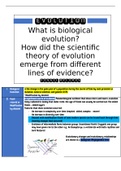Summary
Summary Life Science IEB Evolution Notes
- Course
- Institution
Flashcards that summarize exactly what you need to know about Strand 4: Origin of an idea about origins, Fundamental aspects of evolution and Formation of new species according to the SAGS document. These flashcards will ensure you understand the evolution content well and will help you get through...
[Show more]



